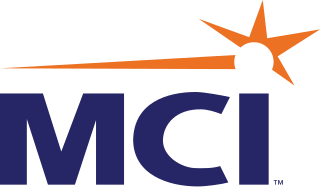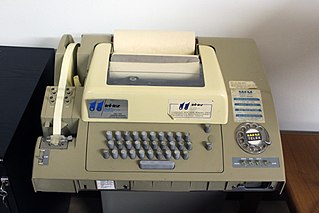Related Research Articles
The Digital Private Network Signalling System (DPNSS) is a network protocol used on digital trunk lines for connecting to PABX. It supports a defined set of inter-networking facilities.

Integrated Services Digital Network (ISDN) is a set of communication standards for simultaneous digital transmission of voice, video, data, and other network services over the digitalised circuits of the public switched telephone network. Work on the standard began in 1980 at Bell Labs and was formally standardized in 1988 in the CCITT "Red Book". By the time the standard was released, newer networking systems with much greater speeds were available, and ISDN saw relatively little uptake in the wider market. One estimate suggests ISDN use peaked at a worldwide total of 25 million subscribers at a time when 1.3 billion analog lines were in use. ISDN has largely been replaced with digital subscriber line (DSL) systems of much higher performance.

MCI Communications Corp. was a telecommunications company headquartered in Washington, D.C. that was at one point the second-largest long-distance provider in the United States.
A voicemail system is a computer-based system that allows users and subscribers to exchange personal voice messages; to select and deliver voice information; and to process transactions relating to individuals, organizations, products, and services, using an ordinary phone. The term is also used more broadly to denote any system of conveying a stored telecommunications voice messages, including using an answering machine. Most cell phone services offer voicemail as a basic feature; many corporate private branch exchanges include versatile internal voice-messaging services, and *98 vertical service code subscription is available to most individual and small business landline subscribers.
In the United Kingdom, Packet Switch Stream (PSS) was an X.25-based packet-switched network, provided by the British Post Office Telecommunications and then British Telecommunications starting in 1980. After a period of pre-operational testing with customers the service was launched as a commercial service on 20 August 1981. The experimental predecessor network (EPSS) formally closed down on 31 July 1981 after all the existing connections had been moved to PSS.
The Plessey Company plc was a British electronics, defence and telecommunications company. It originated in 1917, growing and diversifying into electronics. It expanded after World War II by acquisition of companies and formed overseas companies.
A leased line is a private telecommunications circuit between two or more locations provided according to a commercial contract. It is sometimes also known as a private circuit, and as a data line in the UK. Typically, leased lines are used by businesses to connect geographically distant offices.

Swisscom AG is a major telecommunications provider in Switzerland. Its headquarters are located in Worblaufen near Bern. The Swiss government owns 51.0 percent of Swisscom AG. According to its own published data, Swisscom holds a market share of 56% for mobile, 50% for broadband and 37% for TV telecommunication in Switzerland. Its Italian subsidiary Fastweb is attributed 16% of private clients and 29% of corporate clients share of Italian broadband and is also active in the mobile market.

Cable & Wireless plc was a British telecommunications company. In the mid-1980s, it became the first company in the UK to offer an alternative telephone service to British Telecom. The company later offered cable TV to its customers, but it sold its cable assets to NTL in 2000. It remained a significant player in the UK telecoms market and in certain overseas markets, especially in the former British colonies of the Caribbean, where it was formerly the monopoly incumbent. It was also the main supplier of communication in the British South Atlantic, including Saint Helena and the Falkland Islands. It was listed on the London Stock Exchange and was a constituent of the FTSE 100 Index.
KCOM Group is a UK communications and IT services provider. Its headquarters are in the city of Kingston upon Hull, and it serves local residents and businesses with Internet and telephony services. It was listed on the London Stock Exchange but is now privately owned by Macquarie Group.

The history of mobile phones covers mobile communication devices that connect wirelessly to the public switched telephone network.
Satellite Business Systems (SBS) was a company founded by IBM, Aetna, COMSAT, that provided private professional satellite communications through its SBS fleet of FSS geosynchronous satellites, and was the first company to do so.
Telenet was an American commercial packet-switched network which went into service in 1975. It was the first FCC-licensed public data network in the United States. Various commercial and government interests paid monthly fees for dedicated lines connecting their computers and local networks to this backbone network. Free public dialup access to Telenet, for those who wished to access these systems, was provided in hundreds of cities throughout the United States.
Siemens Communications was the communications and information business arm of German industrial conglomerate Siemens AG, until 2006. It was the largest division of Siemens, and had two business units – Mobile Networks and Fixed Networks; and Enterprise.

ROLM Corporation was a technology company founded in Silicon Valley in 1969. IBM Corp. partnered with the company, and ROLM Mil-Spec was sold to Loral Corporation and later to Lockheed Martin in 1996 as Tactical Defense Systems. IBM's ROLM division was later half sold to Siemens AG in 1989, whereupon the manufacturing and development became wholly owned by Siemens and called ROLM Systems, while marketing and service became a joint venture of IBM with Siemens, called ROLM Company. After nearly 30 years, phone products with the name "Rolm" were discontinued in the late 1990s, as sales dropped in markets dominated by new technology with other products or other companies.
Unified communications (UC) is a business and marketing concept describing the integration of enterprise communication services such as instant messaging (chat), presence information, voice, mobility features, audio, web & video conferencing, fixed-mobile convergence (FMC), desktop sharing, data sharing, call control and speech recognition with non-real-time communication services such as unified messaging. UC is not necessarily a single product, but a set of products that provides a consistent unified user interface and user experience across multiple devices and media types.

Unify, is an Atos company headquartered in Munich, Germany and is present in over 100 countries. The company provides software-based enterprise unified communications including voice, Web collaboration, video conferencing and contact center, networking product and services.
The IBM 1750, 2750 and 3750 Switching Systems were telephone exchange systems produced by IBM from the 1960s to the 1990s.

Telecommunications equipment are hardware which are used for the purposes of telecommunications. Since the 1990s the boundary between telecoms equipment and IT hardware has become blurred as a result of the growth of the internet and its increasing role in the transfer of telecoms data.

The telex network is a station-to-station switched network of teleprinters similar to a telephone network, using telegraph-grade connecting circuits for two-way text-based messages. Telex was a major method of sending written messages electronically between businesses in the post–World War II period. Its usage went into decline as the fax machine grew in popularity in the 1980s.
References
- ↑ Freshwater, R. "IBM 8750". THE TELEPHONE FILE. Retrieved April 29, 2018.
- ↑ Brown, Bob (Dec 19, 1988). "IBM, Siemans carve up ROLM operations". Vol. 5, no. 51. Network World. Retrieved April 29, 2018.
- ↑ IBM brochure G511-1025-0 dated 10/87; System description GA19-5480 and 20 other manuals
- ↑ "History of ROLM, IBM, and Siemens Enterprise Communications".
- ↑ Markoff, John (14 December 1988). "IBM to sell Rolm to Siemens". The New York Times. No. Dec 14, 1088. The New York Times. Retrieved April 29, 2018.